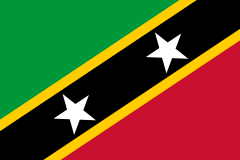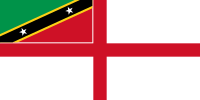Flaga Saint Kitts i Nevis
 | |
| Informacje | |
| W użyciu |
|
|---|---|
| Proporcje | 2:3 |
| Wprowadzona | |
| Projektant | Edrice Lewis |
| Warianty | |
 Bandera wojenna Saint Kitts i Nevis | |
| W użyciu |
|
| Proporcje | 1:2 |
 Flaga gubernatora generalnego Saint Kitts i Nevis | |
| Proporcje | 1:2 |
| Wprowadzona | |
Flaga Saint Kitts i Nevis – jeden z symboli państwowych Saint Kitts i Nevis. Zastąpiła flagę Saint Christopher-Nevis-Anguilla, jest w użyciu od uzyskania przez państwo niepodległości.
Flaga została wybrana w wyniku konkursu.
Wygląd i symbolika
Zielony na fladze symbolizuje urodzajne ziemie wysp, podczas gdy czerwona - walkę z niewolnictwem i kolonizacją. Czarna odnosi się do afrykańskich korzeni kraju, a żółta ma reprezentować blask Słońca świecącego nad całą wyspą. Dwie białe gwiazdy symbolizują dwie wyspy wchodzące w skład państwa, nadzieję i wolność[1][2]. Oficjalną symbolikę flagi sformułował projektant[2].
Flagi historyczne
Flaga Saint Christopher-Nevis-Anguilla (1958-1967)
Flaga Saint Christopher-Nevis-Anguilla (1967)
Flaga Saint Christopher-Nevis-Anguilla (1967–1983)
Zobacz też
Przypisy
- ↑ flag of Saint Kitts and Nevis, [w:] Encyclopædia Britannica [online] [dostęp 2022-08-03] (ang.).
- ↑ a b Complete Flags of the World, Dorling Kindersley Limited, 3 listopada 2008, ISBN 978-1-4053-3302-3 [dostęp 2022-08-03] (ang.).
Media użyte na tej stronie
Federal flag of the West Indies Federation, 3 January 1958 to 31 May 1962
Flag of Saint Christopher-Nevis-Anguilla (1958 - 1983)
Autor: Tcfc2349, Licencja: CC BY-SA 4.0
The colonial flag of Leeward Islands was used between 1871 and 1956 in the Caribbean. The badge was designed by Sir Benjamin Pine, the first Governor. His flag was the Union Jack with the badge on a disc surrounded by a garland of laurel. The flag was used until the dissolution of the Leeward Islands colony in 1956.
Flag of St. Christopher-Nevis-Anguilla used 1958 to 1967.
Autor: Thommy, Licencja: CC0
Flag of the Governor-General of Saint Kitts and Nevis.
Flag of Saint Christopher-Nevis-Anguilla without the palm. Used for a brief period in 1967.














